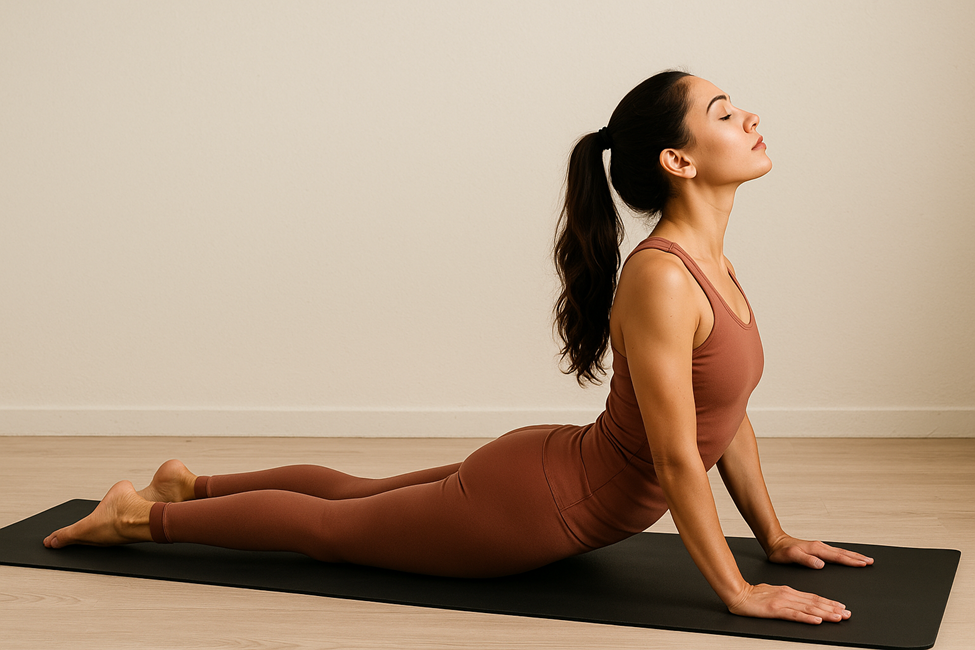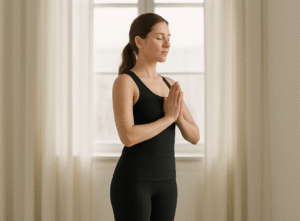Introduction
Anxiety is something most of us face at some point. It can come from stress, old wounds, pressure at work or even just the fast pace of modern life. For some, it’s a passing feeling. For others, it lingers and starts to affect everyday living. In this guide, we look at anxiety through the lens of yoga, time-tested path that doesn’t just manage symptoms but goes deeper to heal the mind, body and spirit.
Yoga offers tools that bring balance to our energy, calm to our thoughts and stability to our emotions. By working with our breath, body and awareness, we can gently shift out of anxious states and into a more grounded, present experience. This isn’t a one-size-fits-all cure, but a framework you can explore at your own pace.
1. Understanding Anxiety
1.1 Why We Feel Anxious
Anxiety doesn’t always have a clear cause. Sometimes it’s triggered by a specific event; other times, it seems to come out of nowhere. It can be linked to health, past experiences, personality traits or simply being overwhelmed by daily life. Each person’s experience is different—and that’s okay. What’s important is recognizing it and learning to respond with care and compassion.
1.2 Common Symptoms
- Fast heartbeat or tight chest
- Shallow breathing
- Irritability or unease
- Trouble sleeping or relaxing
- Constant worry or racing thoughts
- Muscle tension
- Digestive discomfort
- Headaches
- A sense of fear or panic
Anxiety can look and feel different for everyone. Some common signs include:
2. How Yoga Views Anxiety
Yoga views anxiety not just as a mental health issue, but as a sign of imbalance across multiple layers of our being. According to yogic philosophy, we are made up of different levels—the physical body, energy body, emotional mind, deeper wisdom and spiritual essence. Anxiety arises when there is a disconnection or disturbance in any of these layers.
2.1 Scattered Prana (Life Energy)
When our life energy or prana, is blocked or scattered—especially around the heart or belly—we feel tense and restless. This is often the case during anxiety.
2.2 Mental Fluctuations (Chitta Vritti)
In the Yoga sutras, Patanjali describes the mind as full of constant waves or “vrittis.” Anxiety is often one of those waves, driven by fear, uncertainty or imagining worst-case scenarios.
2.3 Disconnection from the Now
Yoga teaches that peace is found in the present moment. Anxiety pulls us away—into the future or past—and we lose our center.
2.4 Chakra Imbalances
- Overactive Solar Plexus (Manipura): Too much energy here can create insecurity and a need to control.
- Weak Root Chakra (Muladhara): A weak root chakra can make us feel unstable, unsupported, and fearful.
3. A Yogic Approach to Relief
3.1 The Five Layers (Panchakosha)
- Physical body (Annamaya): Healed through yoga postures
- Energy body (Pranamaya): Balanced with breathwork
- Mind/emotions (Manomaya): Calmed through meditation and sound
- Wisdom/thoughts (Vijnanamaya): Transformed through reflection and positive affirmations
- Bliss (Anandamaya): Touched through deep rest and spiritual connection
3.2 Practices That Help
- Asana: Yoga poses help release stored tension and ground the body.
- Pranayama: Breathwork soothes the nervous system and restores balance.
- Meditation & Sound: Tools like chanting or mindfulness reduce mental noise.
- Affirmations: Repeating helpful phrases can shift limiting thoughts.
- Journaling Self-Study (Svadhyaya): Writing thoughts down brings clarity and emotional release. Regular journaling deepens insight into triggers, reactions, and beliefs—cultivating emotional intelligence and discernment.
4. Daily Lifestyle for Anxiety Support
4.1 Take Care of the Basics
- Prioritize good sleep
- Eat nourishing meals
- Limit digital overwhelm
- Create daily routines that anchor you
4.2 Seek Connection and Purpose
Finding the Purpose which agrees with you
Having supportive relationships and meaningful activities. Don’t hesitate to reach out for help when needed.
5. Daily Practice Sequence (10–15 Minutes)
Start with few rounds of Surya Namaskar (Sun Salutations)
Surya Namaskar is a dynamic series of poses that enhances circulation, releases physical and emotion tension . Many practitioners have reported significant improvements in anxiety symptoms after incorporating daily sun salutations into their practice. Promoting vitality and emotional stability.
Followed by, lying down pose Savasana
- Breathe fully into the belly, chest, and ribs.
- Let your body melt into the ground.
- Whole body soften and release.
Spinal Twist (Supine)
- Gently twist knees to one side, then the other.
- Calms the spine and massages internal organs.
- Helps release the spine and soothe digestion and gut
Bridge Pose (Setu Bandhasana)
- Strengthens and opens the heart center.
- Use a block or pillow under the sacrum for support.
- Opens the heart and solar plexus.
Fish Pose (Matsyasana) – Use props if needed
- Lie on a bolster or firm pillow to open the chest and release heaviness.
- Let your arms rest wide, palms up.
- Releases tension in the chest and throat.
Bhujangasana (Cobra Pose)
- Lie on your belly, gently lift your chest.
- Activates prana and energizes a tired mind.
- Invites energy and openness into the spine.
Child’s Pose (Balasana)
- Fold forward, arms extended or under your head.
- Deeply grounding and soothing.
- Calming and grounding.
Seated Forward Fold (Paschimottanasana)
- Softly fold over your legs.
- Breathe into the back body.
- Relaxing the head, breathe into the spine and back body
Arm & Shoulder Circulation
- Open the chest.
- Imagine creating space around your heart.
- Release upper body tension. Open and free the chest and shoulders.
Standing Forward Fold (Uttanasana)
- Let your head hang. Avoid if dizzy.
- Releases tension in back and neck.
Breathwork (3–4 minutes)
Sit comfortably and breathe consciously:
- Nadi Shodhana (Alternate Nostril): Balances left/right energy. Enhances mental clarity and calm.
- Sheetali or Sheetkari: Cooling, calming the mind. Cools the body and quiets the mind
- Bhramari (Humming Bee): Vibrational sound calms mental noise. Vibrational sound calms the nervous system and mind.
Sound Healing & Relaxation (2–3 minutes)
Lie down again. Gently chant aloud:
- A (from belly)
- U (from chest)
- M (from head)
Feel each vibration as it flows through your body.
Let the sound quiet the mind and restore your inner rhythm. Gently clearing, rebalancing and restoring.
Final Rest & Observation (1–2 minutes)
Lie still. Let go of all effort.
Simply observe the natural breath.
Allow the body to rest in silence. Entering into meditative state
6. Toolkit
- Journal regularly to understand emotions
- Do yoga to move and ground the nervous system
- Try meditation or Yoga Nidra for deep calm
- Use chants and mantras to reset your energy
- Keep life balanced with good habits and routines
- Reach out for help when needed—support is healing




